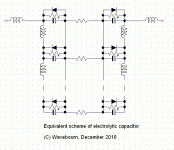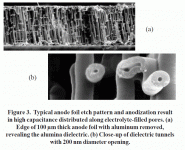I'm with Kevin on choice of voltage ratings. The 250V and below versions (Nichicon, Panasonic, etc) have better specs than the 450v types. Specifically, better temperature degradation of impedance with cold temperatures.... and if your weather is anything like ours now (-5 deg C daytime, freezing fog), this may be worthwhile.
A fuse in the HT circuit, before the caps, is a good idea. They do go bang spectacularly! The Elna Cerafines, which are a better sounding Elko, fail short-circuit in my experience.
In any event, the lifetime of electrolytics is poor - and they sound bad before you can measure anything wrong with the ESR or C value.
The thing about 2 in series is that when the first cap shorts the total capacitance then doubles back to the full capacity of the single. The amp may sound better! Just before it explodes!
Safe bet I guess, and while I prefer SE amps based around DHTs, I have heard a couple of very nice sounding 6AS7 based PP amps. Having designed and built a lot of SE and PP amps over the years I probably would take small issue with you last comment, but to each their own. Both can work well within the context of the system they were designed for.
The particular 6AS7 amp mentioned might be SE and those are a tougher nut to crack. Sources, and speakers in particular are an important element in these sorts of evaluations. WRT to cathode bypass caps I can hear all sorts of things going on which is why I mostly use fixed bias or LEDs or at worse unbypassed cathode resistors where the increased noise and rp are not an issue.
I agree that to use a 6AS7 in a SE context would be very unwise. But in a PP context they will sing as well as any of the more popular triodes.
To my knowledge there have only ever been a handful of truly Class A PP triode amps built (the Amnity springs to mind). Some people image that PP automatically means big watts class AB which means there are very few PP amps which have shown what can be achieved. There are many techniques available to impose perfect symmetry from front to back - and again these are techniques which are almost never used and so most PP amps are far below what the topology has to offer.
It just makes my blood boil to see such ill informed statements.
Shoog
Last edited:
The thing about 2 in series is that when the first cap shorts the total capacitance then doubles back to the full capacity of the single. The amp may sound better! Just before it explodes!
Doesn't Tubelab have first call on that test schedule?
Big electro's used in UPS's make excellent candidates for power supply caps. These are the highest spec. caps for the most demanding and critical applications. I have some 8,000uf 400V ones in my current amp. Bypassing makes a big difference to how they sound though.
Shoog
Shoog
Member
Joined 2009
Paid Member
As somebody noted, you use the 6AS7 in your amp. No wonder you can't hear an improvement. Even the worst possible crapcap can't affect your amp. Try a 2A3 and perhaps other members will start to take you seriously.

the members around here know better than to take me (or anyone) seriously

we're going off topic here, but you have to look at the details. I drive my 6AS7 with a 6SN7, which isn't giving a huge voltage swing. I'm getting an overall gain of only 2, so maybe 1W output. Under these conditions the 6AS7 can be operated in a fairly linear regime. The amp sounds very clean - and I can compare it with the super-clean measuring Bryston (although it doesn't sound as nice of course). I'm not hearing copious H2 from this ampl, it simply isn't being driven hard enough.
In P-P you are really just eliminating the H2, H4 distortion and I don't hear much of this to start with. What the 6AS7 also gives is low plate resistance, a hum-free heater and relatively low cost tubes (actually I'm using Russian tubes based on some recommendations of a friend).
Don't want to spoil the fun but
I think he's pullin yer chain. There's another thread where the "linearity" of 6AS7s is being called into question. SemperFi builds 6AS7 amps...
Ten points to Micky
Glad to see some 6AS7 listeners coming out of the closet
Member
Joined 2009
Paid Member
There is some interesting information in this ap note from Nippon Chemi-Con.
(I was looking for thte KMH Series as I have found about 24ea 1000uF 200V caps headed for the trash.)
Page 5 has a graph that shows that capacitance is fairly stable out to 1KHz, but by 10KHz it is down by over 40% and keeps dropping. This is not capacitive reactance that is dropping, but actual capacitance. I wonder if this fall off in capacitance could be a contributing factor that the film cap is correcting.
http://www.chemi-con.co.jp/e/catalog/pdf/al-e/al-sepa-e/001-guide/al-precaution-e-100701.pdf
The VISHAY General Technical Information app note indicates even MKT Capacitance is only down 5.5% atr 100KHz and MKP is within 1% of value at 100Hz (chart on page 15). So film caps don't have a similar drop in capacitance with frequency.
http://www.vishay.com/docs/26033/gentecin.pdf
(I was looking for thte KMH Series as I have found about 24ea 1000uF 200V caps headed for the trash.)
Page 5 has a graph that shows that capacitance is fairly stable out to 1KHz, but by 10KHz it is down by over 40% and keeps dropping. This is not capacitive reactance that is dropping, but actual capacitance. I wonder if this fall off in capacitance could be a contributing factor that the film cap is correcting.
http://www.chemi-con.co.jp/e/catalog/pdf/al-e/al-sepa-e/001-guide/al-precaution-e-100701.pdf
The VISHAY General Technical Information app note indicates even MKT Capacitance is only down 5.5% atr 100KHz and MKP is within 1% of value at 100Hz (chart on page 15). So film caps don't have a similar drop in capacitance with frequency.
http://www.vishay.com/docs/26033/gentecin.pdf
Member
Joined 2009
Paid Member
Take that serial capping into a failure of one cap. If you want a bomb in your amp just serialise some low voltage caps to get it to work with higher voltage and let one fail with a short into the other one. It won't blow a fuse until the cap explodes. And a big cap explodes in a big way.
Precisely..... so the link given for the low ESR and low ESL caps would need to be evaluated carefully for Wavebourn's application.... even though they would be useful for jet planes...However serialised caps do work quite well if you put a set of voltage divider resistors to ensure the voltages do not swing unequally into the serialised caps.
Last edited:
All this talk of regulator tube amps fuels thoughts of interesting possibilities such as 6AS7 PP with Input Transformer splitter feeding 6EM7s as VAS/drivers. Using both sections of the 6EM7 as common cathode mode should give enough gain and current drive to push the 6AS7 to full output I think. But I am getting a bit off topic hear. We return you to your regularly scheduled programing. 
Here are guts of an electrolytic capacitor from the paper: http://www.cde.com/tech/impedance.pdf
Attachments
There is some interesting information in this ap note from Nippon Chemi-Con.
(I was looking for thte KMH Series as I have found about 24ea 1000uF 200V caps headed for the trash.)
Page 5 has a graph that shows that capacitance is fairly stable out to 1KHz, but by 10KHz it is down by over 40% and keeps dropping. This is not capacitive reactance that is dropping, but actual capacitance. I wonder if this fall off in capacitance could be a contributing factor that the film cap is correcting.
He's filtering PS! There ain't supposed to be anything in there but what's coming out of the rectifier... No mention of any noise or even a suggestion that anything else is there. Nothing other than a nearly "perfectly tuned" amp that "didn't sound real."...
PS supplies power to the output stage. It is actually in series with output tubes and primary windings of output transformers. If output resistance of PS is non-linear this non-linearities add to non-linearities of output signal. If PS has non-linear resistance it causes non-linearities that are well visible on FFT plots, when non-linear capacitance, it causes phase - related non-linearities that affect stereo image even when are hard to observe by static measurements. When Matti Otala first spoke of them loudly he was confronted by the crowd that did not believe that such small amont of distortions can be audible.
- Status
- This old topic is closed. If you want to reopen this topic, contact a moderator using the "Report Post" button.
- Home
- Design & Build
- Parts
- Mumbo-Jumbo and power supply caps



